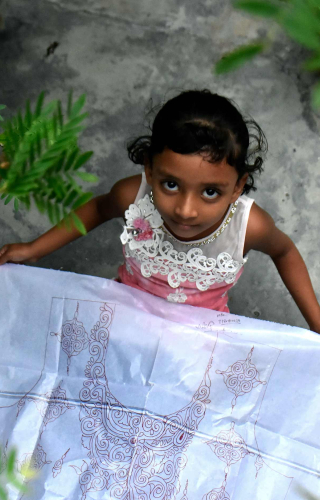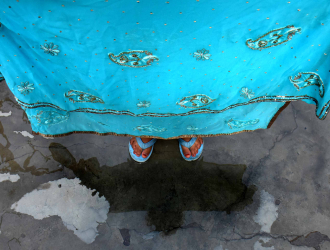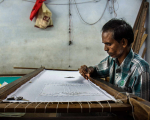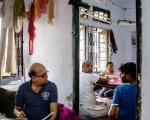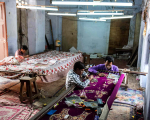Mughal rule in India witnessed significant aesthetic influences from Iran, of which zardozi became particularly popular amongst the Mughal elite. Zardozi is a Persian word that means ‘sewing with gold string’. It derives from zar, that is, gold, and dozi, embroidery. And the craftspeople who work with this medium are known as zardos or zardosans.
Originally zardozi was done with pure silver and gold wires on silk, satin and velvet fabrics, and the process was known as kalabattu. Nowadays, the wires used are gold-plated, silver-plated or copper-plated threads. Other than metal wire, zardozi work also uses dabka (a spring-type thread), kora, katori, tikena, and sitara (sequins) for embellishment. Sometimes—if specifically requested by a paying customer—expensive embellishments like pearls, quills, precious and semi-precious stones are also used. In the past, the more aesthetic and evolved forms of embroidery were used on court costumes, and especially on accessories such as shoes and sword scabbards. Grand to look at, zardozi embroidery can weigh a lot. The crochet-like needle which is used to cast this embroidery is attached to a wooden stick with a hook at the end. This needle is known as aari; hence the embroidery is also referred to as aari work.
Zardozi work flourished in Lucknow under the patronage of the Nawabs of Awadh, especially Nawab Wajid Ali Shah (reign 1847–56). And throughout the 18th and 19th centuries, aari and zardozi became popular with the wealthy Hindu, Muslim and European social elite in various urban centres such as Hyderabad, Calcutta, Varanasi, Bhopal, Kashmir and Delhi. For my documentation work, I visited workshops in the Kashmiri Mohalla and Agha Mir Deori neighbourhoods in Lucknow, Uttar Pradesh.
Kashmiri Mohalla got its name from the community of Kashmiri Pandits who originally settled in this region when the Awadh court was shifted from Faizabad to Lucknow in 1775. Only 40 Kashmiri Pandit families now live in the Kashmiri Mohalla, out of the original settlement of a thousand families; the rest have migrated to other cities. According to the local trade union, 70 per cent of Kashmiri Mohalla’s population is engaged in zardozi work, comprised mostly of Shia Muslims. The karkhanas (workshops) here supply articles of finished zardozi work, which are sold in showrooms in Aminabad and Hazratganj. The karkhanas are owned by a karkhandar, who hires craftsmen and oversees the production. The zardosans get into the craft at an early age, and they often belong to the same family, learning the craft through generations of skill transfer.
Zardozi connoisseurs prefer the designs to be custom made, and they select sample patches in the showrooms. These patches are then sent to the workshop with annotations instructing the karkhandars about the type of raw materials to be used, quality and colour of the fabric, finishing techniques, etc. The final design is traced on a tracing sheet and holes are made along the traced pattern using a needle. The fabric, on which the embroidery is to be done, is placed on a flat table and the tracing sheet is fixed over it. Next, a solution of kerosene and Robin Blue (a fabric whitener) is applied with a wad of cloth against the tracing paper. The solution seeps through the holes to trace the design on the fabric. Then the fabric is stretched taut over a wooden frame called the adda. The adda can be adjusted to fit fabrics of any size, and stretch them tightly to provide uniform tension across the entire fabric. The frame itself can comfortably accommodate five to seven artisans working together. The aari greatly enhances the speed of the work, as it enables the artisan to pass the threads both above and below the fabric. This method of embroidery is very time-consuming and requires significant patience and skill. Hence, the work is expensive.
The Ministry of Textiles has estimated that there are more than 10,000 micro and small enterprises that are involved in making zardozi products in Lucknow. Traditionally, only males used to perform these embroideries, but now 15 per cent of the artisans are women. However, the craft has been in terminal decline in Kashmiri Mohalla and Agha Mir Deori, and there are a number of reasons for this. New competition has emerged on the outskirts of the city, affecting the price of the zardozi work done in the old neighbourhoods, where the craft had largely been a Shia monopoly. These new workshops are controlled by Sindhis and Punjabis, and they get work done from villages at lower costs, often by copying original designs.
To counter the theft of design and stockpiling, the zardosans had established an organisation called the Anjuman-e-Zardozan in 1971. However, it began to lose significance in the 1990s because promises made to workers about increases in wage could not be fulfilled. It closed in early-2000, and the concept of paying daily or weekly wage was abandoned. Workers who were earning daily wages started getting paid per piece and had to work on stricter deadlines. Such artisans, who work around 7–8 hours per day, now earn just Rs 150 for a day’s work. Rising costs of raw material like gold and silver, and competition from Chinese machinery, have also added to their woes. Though demand remains high, the proliferation of fake and imitation articles has brought down the trade as also market prices for high-quality zardozi.
According to practising zardosans, the craft that was once a regal profession, has now become just a money-making mechanism for the karkhandars, fashion designers and stockist businessmen who exploit the zardosans and their skills. This is very unfortunate, and many zardosans have left their trade, or have migrated out of their mohallas to search for better jobs or pursue higher education. The survival of the craft is important not only for the zardosans but also for Lucknow’s own distinct Awadhi culture and tehzeeb (etiquette), of which zardozi has always been a much-loved visual icon.
